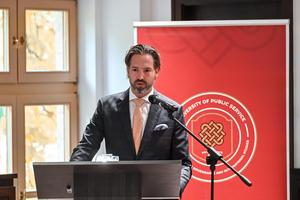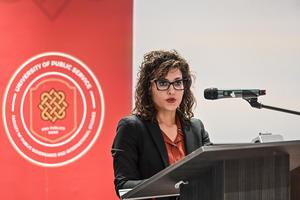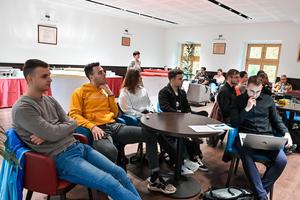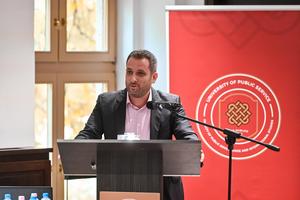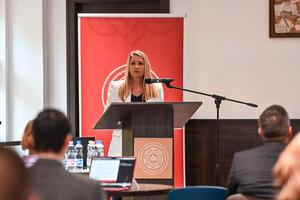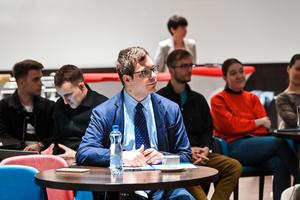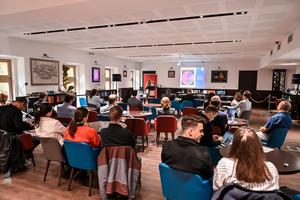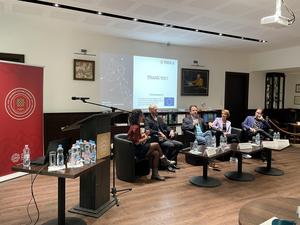The conference of the Faculty of Public Governance and International Studies (FPGIS) of the Ludovika University of Public Service (LUPS) on October 13 sought answers to questions such as the impact of disinformation on society and how science can contribute to managing these effects.
The conference was opened by Balázs Bartóki-Gönczy, the Deputy Dean of FPGIS, who stated that the world is changing rapidly and unpredictably, and we cannot be certain if it's in the right direction, especially when considering phenomena like disinformation, fake news, or deep fakes. He posed the question of how adequate research can be conducted in this situation and how its results can be effectively communicated. According to him, this task requires great adaptability because science needs to communicate credibly in an extremely noisy information environment.
Nóra Falyuna, the Head of the Science and Society Research Group of FPGIS, emphasised in her opening remarks that in today's information society, the relationships between science and all segments of society continuously raise relevant questions, including the interpretation of misleading phenomena. The research workshop aligns with international scientific and professional trends, addressing the connections between science and society, science communication strategies, and the role of science in studying disinformation. Misinformation and intentional deception can have serious social consequences, as seen during the coronavirus pandemic and neighbouring conflicts, which have favoured the spread of fake news. She stressed the importance of examining the issue of trust in science and the necessity of collaborations between different scientific disciplines and between science and society in this context.
The conference's distinguished plenary speakers, Bernát Török, the Director of the József Eötvös Research Center, and Joseph E. Uscinski, Professor at the University of Miami, along with other speakers and participants in the closing panel discussion, responded to the relationships between science, society, and disinformation from various perspectives.
In his presentation, Bernát Török highlighted the legal aspects related to disinformation. He emphasised that the law is the tool to "establish order," but it cannot be the means to manage disinformation; it can only intervene at certain points. He believes that large societal systems have much greater responsibility. Török explained what disinformation means in legal practice and underscored the need for credible sources and information flow.
Ágnes Veszelszki, the Head of the Department of Digital Media and Communication at FPGIS, explored how artificial intelligence affects science communication. The presentation addressed new issues in plagiarism and copyright due to training new technologies and their impact on the copyright of texts used for training. These technologies offer several advantages in new scientific communication trends, such as the emergence of virtual scientific influencers or the production of more vivid verbal and visual scientific educational content. However, she emphasised that creativity could suffer due to these developments, as researchers increasingly ask ChatGPT, "What should my presentation be about," reinforcing a lack of originality.
In their presentation, Dalma Dominek, the Head of the Experiential Digital Education Research Workshop, and Nóra Barnucz, the Deputy Head of the Workshop, introduced the work and concept of the Research Workshop. They specifically addressed digital competence, ICT tools, and primarily the role of flow experience in today's knowledge transmission and acquisition processes.
Péter Bányász, Associate Professor at the Department of Cybersecurity at FPGIS, discussed the disinformation wave related to the Russian-Ukrainian conflict and its cybersecurity, social, and psychological aspects. He emphasised that influence has always played a role in warfare throughout history, but nowadays, its possibilities and potential impact are more significant.
Joseph E. Uscinski, Professor of the University of Miami, guided the audience into the world of conspiracy theories. He highlighted that there are hundreds of studies indicating a correlation between the use of social media and the appearance and spread of conspiracy theories. However, he emphasised that this correlation does not necessarily imply a cause-and-effect relationship. Uscinski explained that conspiracy theories existed before the internet, and whether someone believes in them depends more on certain susceptibility than on social media consumption. He presented some popular conspiracy theories in the United States, relating them to the conference theme and highlighting recent scientific conspiracy theories.
Gábor Szüdi, a researcher and project manager at the Centre for Social Innovation in Vienna, delivered a presentation on the role of science communication in evidence-based policymaking based on the insights and results of the TRESCA project under the EU Horizon 2020 program. The presentation pointed out that science communication is crucial today but faces many challenges fueled by uncertainty and mistrust. The project aims to establish a new science communication ecosystem that is more adaptable, reliable, and collaborative in today's information environment.
The event concluded with a panel discussion involving Joseph Uscinski, Gábor Szüdi, and three members of the Research Workshop: Márton Demeter (university professor, head of the Strategic Science Office of LUPS), Katalin Fehér (associate professor, Strategic Science Office of LUPS), and Falyuna Nóra. The discussion focused on factors and circumstances shaping society's perception of science today, the impact of digital culture on science communication as well as scientific knowledge production processes, how artificial intelligence affects trust and credibility, and how the relationship between science and business development manifests in the logic of conspiracy theories expressing distrust.
Text: Éva Harangozó
Photo: Dénes Szilágyi
